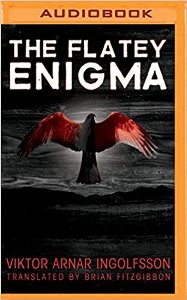Viktor Arnar Ingólfsson is an Icelandic crime fiction writer and public roads administrator. He has written six novels to date, four of which have been translated into English, and he has twice been the Icelandic nominee for the Scandinavia-wide Glass Key Award for crime fiction.

(As indicated by the above image, I listened to this one as an audiobook. I’m not sure the story was ideally suited to the audiobook format—each chapter is structured in two parts, with the nature of the second, shorter part not properly becoming clear until late in the book; and there are a number of places where the text features 39-character-long strings of individual letters, more-or-less meaningless in audio but of reasonable relevance to the story—but the audiobook’s gimmick of using a male narrator for the first part of each chapter and a female narrator for the second part worked well enough, even if it was quite confusing for the first couple of chapters.)
The Flatey Enigma (Flateyjargáta, 2003, translated by Brian Fitzgibbon) starts with the discovery in spring 1960, by a family of seal-hunters from the small West Icelandic island of Flatey (pronounced Flah-tay), of the badly-decomposed body of a man on the smaller uninhabited island of Ketilsey. Kjartan, an inexperienced assistant to the District Magistrate, is initially sent to Flatey to investigate the death, but by the time the body is identified as that of a Danish professor who had been visiting Flatey the previous year, it has become apparent that none of the islanders is able to explain how and why the professor made his way to Ketilsey and met his death. Suspicion grows that the death is related to the academic’s researches into the (genuine) medieval Book of Flatey, for which the vellum original is held in Copenhagen and a modern copy is stored in the island’s small library. The Flatey copy of the text also contains the only known copy of the (fictitious) Flatey Enigma, a forty-question puzzle which relates to the content of the Book and which carries a curse applicable to anyone who attempts to transcribe it or to remove it from the library, and it appears the professor had indeed attempted this.
The book is slow to unfold and rather gruesomely authentic, not so much for the descriptions of contemporary murder (which are detailed enough) but for the Book of Flatey extracts summarised in several of the latter portions of chapters: if you were ever wondering how the Norse acquired such a bloodthirsty reputation, the tales from the Book of Flatey should provide an answer, with beheadings, eviscerations and sundry mutilations galore … and then there’s the ritualistic slaying method described as the ‘Blood Eagle’. The islanders’ cuisine, too, also sounds rather grim, revolving around boiled seal meat, fermented shark, and various forms of cooked seabird (puffin appears to feature heavily on this score). Behind all of this, the story presented is sufficiently intriguing to retain interest, though it is sometimes difficult to tell the various characters apart: while they are given distinct personalities, they are not always as sharply delineated as one might wish.
The resolution of the several mysteries within the book is satisfying, but there’s a distinct sense in which the crime plays second fiddle to the gritty detail of the story’s setting.
Leave a comment